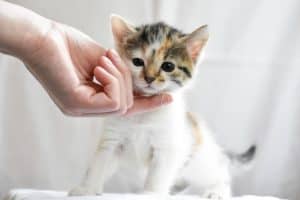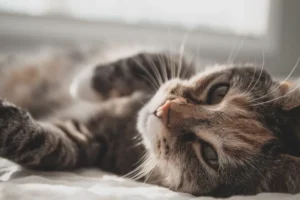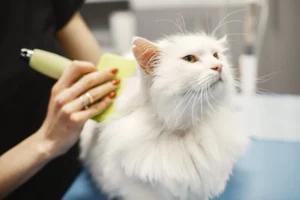Have you ever noticed your feline friend lounging around without a care in the world? If you’re wondering why your cat seems to be stationary all day, you’re not alone. Understanding the reasons behind your cat’s lack of movement can help ensure their health and happiness.
Physical Health Factors
If your cat is unusually lethargic and not moving all day, it could be a sign of underlying physical health issues. Obesity is a common issue that can lead to decreased activity levels in cats. Make sure to monitor your cat’s weight and consult with your veterinarian on a healthy diet plan.
Joint pain or arthritis may also be causing your cat discomfort, making it reluctant to move around. Keep an eye out for any signs of stiffness or limping, and seek professional advice on how to manage these conditions effectively.
Other potential physical health factors to consider include thyroid problems, diabetes, or heart conditions. If you notice any changes in your cat’s behavior or activity levels, it’s essential to have them evaluated by a vet promptly. Regular check-ups and proper healthcare can help identify and address any underlying health issues that may be affecting your cat’s mobility.
Environmental Factors
Your cat’s surroundings and daily routine can play a significant role in their activity levels. Boredom and lack of stimulation can lead to lethargy in cats. Make sure your cat has access to engaging toys, scratching posts, and interactive playtime to keep them mentally and physically active.
Stress or anxiety can also impact your cat’s behavior and energy levels. Changes in the household environment, new pets, or loud noises can cause stress in cats. Creating a calm and secure environment for your cat can help alleviate these issues and encourage them to be more active.
Additionally, temperature and lighting can affect your cat’s activity levels. Ensure that your cat has a comfortable and well-lit space to move around freely. Providing sunny spots for lounging or warm blankets for snuggling can make a significant difference in your cat’s overall well-being.
Remember, understanding your cat’s needs and addressing any potential physical health issues or environmental factors is key to helping them stay active and healthy. By observing their behavior and making necessary adjustments, you can ensure that your feline friend leads a happy and active life.
Behavioral Considerations
If your cat is not moving much during the day, there could be several behavioral reasons to consider. Stress, boredom, or even a change in routine can all impact your cat’s activity levels. Cats are creatures of habit, so any disruption in their environment or routine might cause them to be less active. It’s essential to create a safe and stimulating environment for your cat to encourage movement. Providing interactive toys, scratching posts, and cozy resting spots can help keep your cat engaged and active throughout the day.
Exercise Requirements
Cats, like any other pet, need regular exercise to stay healthy and active. Just like humans, cats need physical activity to maintain their overall well-being. Ensure you’re providing your cat with enough playtime and opportunities to move around. Interactive toys, laser pointers, or even a simple cardboard box can stimulate your cat’s natural hunting instincts and encourage movement. Additionally, dedicating time each day to play and interact with your cat can strengthen your bond and keep them active. Remember, a happy and healthy cat is an active cat!
Mental Stimulation
Is your cat not moving much during the day? It could be that they need more mental stimulation. Cats are natural hunters and need mental challenges to stay active. Try introducing puzzle toys, hiding treats around the house, or even setting up a bird feeder outside a window to keep your cat engaged and moving.
In addition to physical activity, mental stimulation can help keep your cat’s mind sharp and prevent boredom. Consider rotating their toys regularly to keep things interesting and provide a variety of experiences for them to explore. Engaging your cat’s mind can lead to increased activity levels throughout the day.
Consultation with a Veterinarian
If your cat continues to show little to no movement despite efforts to increase mental stimulation, it may be time to consult with a veterinarian. While some cats are naturally more sedentary, sudden changes in activity levels could be a sign of an underlying health issue.
A veterinarian can perform a thorough examination, including blood tests and physical assessments, to rule out any potential health concerns. They can also provide tailored advice on how to best address your cat’s specific needs and recommend any necessary treatments or changes to their routine to improve their overall well-being.
Remember, seeking professional advice is crucial to ensure the best possible care for your feline friend. Don’t hesitate to reach out to your veterinarian if you have any concerns about your cat’s activity levels.
Additional Unique Insight:
If your cat is older, their decreased activity levels may be due to age-related issues such as arthritis or joint pain. Consulting with a veterinarian can help determine the best course of action to ensure your senior cat stays comfortable and active.
Making Changes for a Happy, Active Cat
If your cat is not moving much throughout the day, there are a few things you can do to encourage more activity. First, try incorporating interactive toys into your cat’s environment. Toys that mimic prey-like movements can entice your cat to play and move around. Additionally, consider setting aside dedicated playtime each day to engage your cat in active play sessions. This can help stimulate both their body and mind.
Another way to promote movement is by creating vertical spaces for your cat to explore. Cats naturally enjoy climbing and perching in high places, so investing in a cat tree or shelving units can provide opportunities for them to move around and jump. Providing scratching posts or pads can also encourage your cat to stretch and move their muscles.
Lastly, ensure your cat has access to a variety of engaging environments within your home. Cats thrive on variety and novelty, so rotating their toys, rearranging furniture, or introducing new hiding spots can keep them mentally stimulated and active throughout the day.
Fun Facts About Cat Behavior
Did you know that cats are crepuscular animals, meaning they are most active during dawn and dusk? This natural instinct comes from their hunting ancestry when they would hunt at these times. So, if your cat seems lethargic during the day, it might just be their natural behavior kicking in.
On a related note, cats are masters of conserving energy. In the wild, this skill helped them survive when food was scarce. So, if your cat spends a lot of time lounging around, it’s likely because they are conserving their energy for when they need it most.
Another interesting fact is that cats are typically more interested in short bursts of intense play rather than prolonged activities. So, providing your cat with quick, engaging play sessions multiple times a day can be more effective than one long play session.
In addition, cats are known to sleep for an average of 12-16 hours a day. This sleep pattern is completely normal for felines and allows them to recharge their energy for periods of activity.
Remember, every cat is unique, so observing your cat’s behavior and preferences can help you tailor their environment to promote a healthy and active lifestyle.
Alex, a passionate animal lover, has experience in training and understanding animal behavior. As a proud pet parent to two dogs and three cats, he founded AnimalReport.net to share insights from animal experts and expand his knowledge of the animal kingdom.




